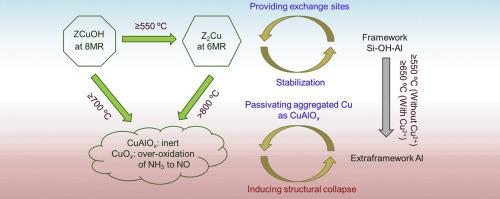Applied Catalysis A: General ( IF 4.7 ) Pub Date : 2020-05-22 , DOI: 10.1016/j.apcata.2020.117650 Yue Ma , Xiaodong Wu , Songqi Cheng , Li Cao , Liping Liu , Yunfan Xu , Jianbo Liu , Rui Ran , Zhichun Si , Duan Weng

|
To investigate possible relationships between copper speciation and Brønsted acidity evolution during hydrothermal aging, a series of aged Cu-SSZ-13 catalysts were prepared by varying aging temperatures from 550 to 850 °C. Besides selective catalytic reduction of NOx by NH3 (NH3-SCR), NH3 oxidation was also adopted as a probe reaction. The catalysts were characterized by H2 temperature-programmed reduction (H2-TPR), in-situ diffuse reflectance infrared Fourier transform spectroscopy (DRIFTS) and magic angle spinning nuclear magnetic resonance (MAS NMR). Isolated Cu ions protect Si-O(H)-Al sites against hydrothermal cleavage, but aggregated Cu species are found to destroy the zeolite framework. Due to the instability of ZCuOH (Z represents negatively charged zeolite [Si-O-Al]– site) at 8-member ring sites, mild hydrothermal aging induces the migration of metastable [Cu(OH)]+ ions to unsaturated 6-member ring sites to form Z2Cu, and excess [Cu(OH)]+ ions start to aggregate at 700 °C. The formation of two types of aggregated Cu species, CuAlOx and CuOx, and their roles in SCR reaction were distinguished. The former one originates from the combination of Cu with extraframework Al and is inert, while the latter forms upon more severe aging and catalyzes over-oxidation of NH3 toward NO, which degrades high-temperature SCR activity.
中文翻译:

Cu-SSZ-13水热时效过程中铜形态与布朗斯台德酸度演变的关系
为了研究水热老化过程中铜形态与布朗斯台德酸度演变之间的可能关系,通过在550至850°C之间改变老化温度,制备了一系列老化的Cu-SSZ-13催化剂。除了通过NH 3(NH 3 -SCR)选择性催化还原NO x之外,还采用NH 3氧化作为探针反应。通过H 2程序升温还原(H 2 -TPR)原位表征催化剂漫反射红外傅里叶变换光谱(DRIFTS)和魔角旋转核磁共振(MAS NMR)。隔离的铜离子可保护Si-O(H)-Al部位免受水热裂解,但发现聚集的铜物质会破坏沸石骨架。由于ZCuOH的不稳定性(Z表示8元环位上的带负电的沸石[Si-O-Al] –位),温和的水热老化导致亚稳[Cu(OH)] +离子迁移至不饱和6元环位置形成Z 2 Cu,并且过量的[Cu(OH)] +离子在700°C时开始聚集。CuAlO x和CuO x两种聚集的铜物质的形成,并区分了它们在SCR反应中的作用。前者源自铜与骨架外Al的结合,呈惰性,而后者则是在更严重的老化后形成,并催化NH 3向NO的过度氧化,从而降低了高温SCR活性。











































 京公网安备 11010802027423号
京公网安备 11010802027423号